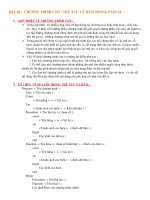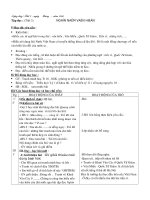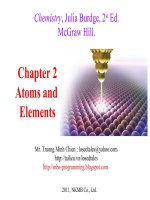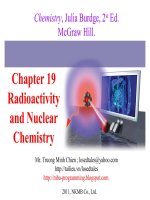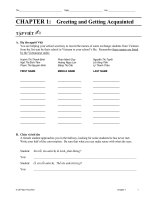Tài liệu Chapter 2 Atoms and Elements
Bạn đang xem bản rút gọn của tài liệu. Xem và tải ngay bản đầy đủ của tài liệu tại đây (1.9 MB, 41 trang )
Chapter 2
Atoms and
Elements
2011, NKMB Co., Ltd.
Chemistry, Julia Burdge, 2
st
Ed.
McGraw Hill.
Mr. Truong Minh Chien ;
/>
Modern Evidence for Atoms
IBM's Almaden Research Center in San Jose,
California, April 1990
2
Chemistry, Julia Burdge, 2
nd
e., McGraw Hill.
Tro, Chemistry: A Molecular Approach 3
Scientists First To Image
'Anatomy' Of A Molecule
ScienceDaily (Aug. 29, 2009) —
IBM scientists have been able to
image the “anatomy” -- or chemical
structure, chemical bonds -- inside
a molecule with unprecedented
resolution, using a complex
technique known as noncontact
atomic force microscopy.
4
Scanning Tunneling Microscope
•
Gerd Bennig and Heinrich
Rohrer found that as you pass
a sharp metal tip over a flat
metal surface, the amount of
current that flowed varied with
distance between the tip and
the surface
•
measuring this “tunneling”
current allowed them to scan
the surface on an atomic scale
– essentially taking pictures of
atoms on the surface
Chemistry, Julia Burdge, 2
nd
e., McGraw Hill.
5
Operation of a STM
6
Early Philosophy of Matter
•
Some philosophers believed that matter had an ultimate,
tiny, indivisible particle
Leucippus and Democritus
•
Other philosophers believed that matter was infinitely
divisible
Plato and Aristotle
•
Since there was no experimental way of proving who
was correct, the best debater was the person assumed
correct, i.e., Aristotle
Chemistry, Julia Burdge, 2
nd
e., McGraw Hill.
7
Scientific Revolution
•
in the late 16
th
century, the scientific approach to
understanding nature became established
•
for the next 150+ years, observations about
nature were made that could not easily be
explained by the infinitely divisible matter
concept
Chemistry, Julia Burdge, 2
nd
e., McGraw Hill.
8
Law of Conservation of Mass
•
in a chemical reaction, matter
is neither created nor
destroyed
•
total mass of the materials
you have before the reaction
must equal the total mass of
the materials you have at the
end
total mass of reactants = total
mass of products
Antoine Lavoisier
1743-1794
Chemistry, Julia Burdge, 2
nd
e., McGraw Hill.
9
Reaction of Sodium with Chlorine to
Make Sodium Chloride
•
the mass of sodium and chlorine used is determined by the
number of atoms that combine
•
since only whole atoms combine and atoms are not changed or
destroyed in the process, the mass of sodium chloride made must
equal the total mass of sodium and chlorine atoms that combine
together
7.7 g Na + 11.9 g Cl
2
→ 19.6 g NaCl
Chemistry, Julia Burdge, 2
nd
e., McGraw Hill.
10
Law of Definite Proportions
•
All samples of a given
compound, regardless of
their source or how they
were prepared, have the
same proportions of their
constituent elements
Joseph Proust
1754-1826
Chemistry, Julia Burdge, 2
nd
e., McGraw Hill.
11
Proportions in Sodium Chloride
54.1
g 39.3
g 7.60
Na of mass
Cl of mass
==
a 100.0 g sample of sodium
chloride contains 39.3 g of sodium
and 60.7 g of chlorine
a 200.0 g sample of sodium
chloride contains 78.6 g of sodium
and 121.4 g of chlorine
54.1
g 78.6
g 21.41
Na of mass
Cl of mass
==
a 58.44 g sample of sodium chloride
contains 22.99 g of sodium and
35.44 g of chlorine
541.1
g 22.99
g 5.443
Na of mass
Cl of mass
==
Chemistry, Julia Burdge, 2
nd
e., McGraw Hill.
12
Law of Multiple Proportions
•
When two elements,
(call them A and B),
form two different
compounds, the
masses of B that
combine with 1 g of A
can be expressed as a
ratio of small, whole
numbers
John Dalton
1766-1844
Chemistry, Julia Burdge, 2
nd
e., McGraw Hill.
Law of Multiple Proportions animat
ion
Tro, Chemistry: A Molecular Approach 13
14
Oxides of Carbon
•
carbon combines with oxygen to form
two different compounds, carbon
monoxide and carbon dioxide
•
carbon monoxide contains 1.33 g of
oxygen for every 1.00 g of carbon
•
carbon dioxide contains 2.67 g of
oxygen for every 1.00 g of carbon
•
since there are twice as many oxygen
atoms per carbon atom in carbon dioxide
than in carbon monoxide, the oxygen
mass ratio should be 2
2
g 1.33
g 2.67
monoxide carbon in carbon of g 1 withcombines that oxygen of mass
dioxide carbon in carbon of g 1 withcombines that oxygen of mass
==
Chemistry, Julia Burdge, 2
nd
e., McGraw Hill.
15
Dalton’s Atomic Theory
•
Dalton proposed a theory of matter based on it having
ultimate, indivisible particles to explain these laws
1) Each element is composed of tiny, indestructible
particles called atoms
2) All atoms of a given element has the same mass and
other properties that distinguish them from atoms of
other elements
3) Atoms combine in simple, whole-number ratios to form
molecules of compounds
4) In a chemical reaction, atoms of one element cannot
change into atoms of another element
they simply rearrange the way they are attached
Chemistry, Julia Burdge, 2
nd
e., McGraw Hill.
16
Some Notes on Charge
•
Two kinds of charge called
+ and –
•
Opposite charges attract
+ attracted to –
•
Like charges repel
+ repels +
– repels –
•
To be neutral, something
must have no charge or
equal amounts of opposite
charges
Chemistry, Julia Burdge, 2
nd
e., McGraw Hill.

